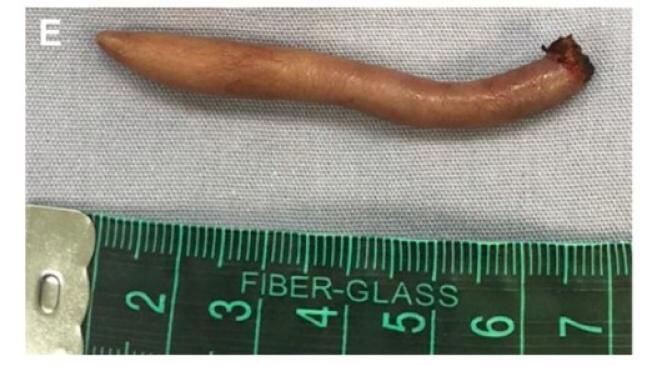“Human tails are extremely rare and are generally diagnosed after birth,” the doctors wrote in a scientific article in the specialized journal ‘Journal of Pediatric Surgery Case Reports’ when attending an unusual delivery, as they raised a baby with said peculiarity .
The event occurred in the state of Nuevo León, in Mexico. Although the identity of the minor was not revealed, the scientific publication specified that the parents were healthy and that they even had another child without any complications. This is considered the first case in that country, although throughout the world there are records of more.
Look: López Obrador asks the US to clarify the whereabouts of drug trafficker ‘La Barbie’
According to the report, two doctors, led by Dr. Josué Rueda, the pregnancy was uneventful, but when they checked the newborn they saw that the limb was sticking out at the end of her tailbone. Apparently, she could move without causing the baby pain, but she did not have any kind of spontaneous movement. During the tests, the girl cried when she was pricked with a needle, which proved that she had nerve connections.
“The structure was smooth, covered with skin and fine hair. (…) The baby cried when the structure was punctured with a needle”, they explained.
The limb was only visible outside of its mother’s womb. It was 5.7 centimeters long, between 3 and 5 millimeters in diameter and was located in the intergluteal cleft.The article stated that the birth of the little girl had occurred normally. She was a cesarean section in a rural hospital. In addition, during pregnancy there was no record of exposure to radiation or teratogens, which are the agents capable of birth defects.
How was the tail formed?
Specialists describe that there are two types of human tails. The first are pseudotails, which are growths that look like tails but actually originate from the spine or tumors. On the other hand, true tails contain muscles, blood vessels, and nerves.
After detecting this anomaly, an X-ray was taken which ruled out irregularities or bone structures within the tail. An abdominal ultrasound also eliminated the chances of renal and urinary tract malformations or vesicoureteral reflux. The MRI did not reveal any brain abnormality either. His spinal cord also had normal characteristics. As she was a healthy baby, she was discharged to continue her outpatient treatment.
Two months after delivery, the little girl returned to be examined by specialists. As described in the report for the scientific journal, she had “the appropriate weight and growth for her age.” Her tail, likewise, had grown 0.8 centimeters “with no evidence of skin lesions.”
After the valuation, They determined that it should be removed, so they anesthetized the baby and removed her tail in a process that had no complications. The affected part was reconstructed using Limberg plasty.
“The histopathological report revealed that the piece contained soft tissues, including fibrofatty tissue, vascular structures and nerve bundles, covered by skin, without histopathological alterations,” they commented in the letter.

Once stolen, the minor was discharged. She did not register complications in recovery.
Was it a real tail?
Based on the medical classification, this structure could be a tail or a pseudo-tail (the latter look like one, but are anomalies of the vertebrae, lumps of fat, among others). Nevertheless, thanks to the analysis, it was verified that it was a real tail.
Human tails have fatty, connective, and muscular tissue. They differ from other pieces because they do not contain vertebrae or any bone structure.
“It was not associated with other malformations, also presenting in the sacrococcygeal region, which is the most frequent location of human tails,” they concluded.
Although it would be the first record of this type in Mexico, in Latin America there was a case in Brazil. There doctors reported a child who was born vaginally prematurely at 35 weeks, who had a 12-centimeter tail.

“Showing an axis with adipose, muscle and neural connective tissue, as well as large vascular branches and absence of bone or cartilage tissue, classified as a true human tail”, they stated in a scientific article for the ‘Journal of Pediatric Surgery Case Reports’.
Source: Elcomercio
I am Jack Morton and I work in 24 News Recorder. I mostly cover world news and I have also authored 24 news recorder. I find this work highly interesting and it allows me to keep up with current events happening around the world.

:quality(75)/cloudfront-us-east-1.images.arcpublishing.com/elcomercio/TSKAJKJUCRHYVJ3PSA6OUN4EIU.jpeg)

:quality(75)/cloudfront-us-east-1.images.arcpublishing.com/elcomercio/LCKCXYDLVNDPLCUH2R4XFW7OZE.jpg)
:quality(75)/cloudfront-us-east-1.images.arcpublishing.com/elcomercio/6T5VR63ZIVHVHIZXGIZCSUVBCM.jpg)

:quality(75)/cloudfront-us-east-1.images.arcpublishing.com/elcomercio/KZF4DNPZPZA2TKJZPUBCR4D2YU.jpg)
